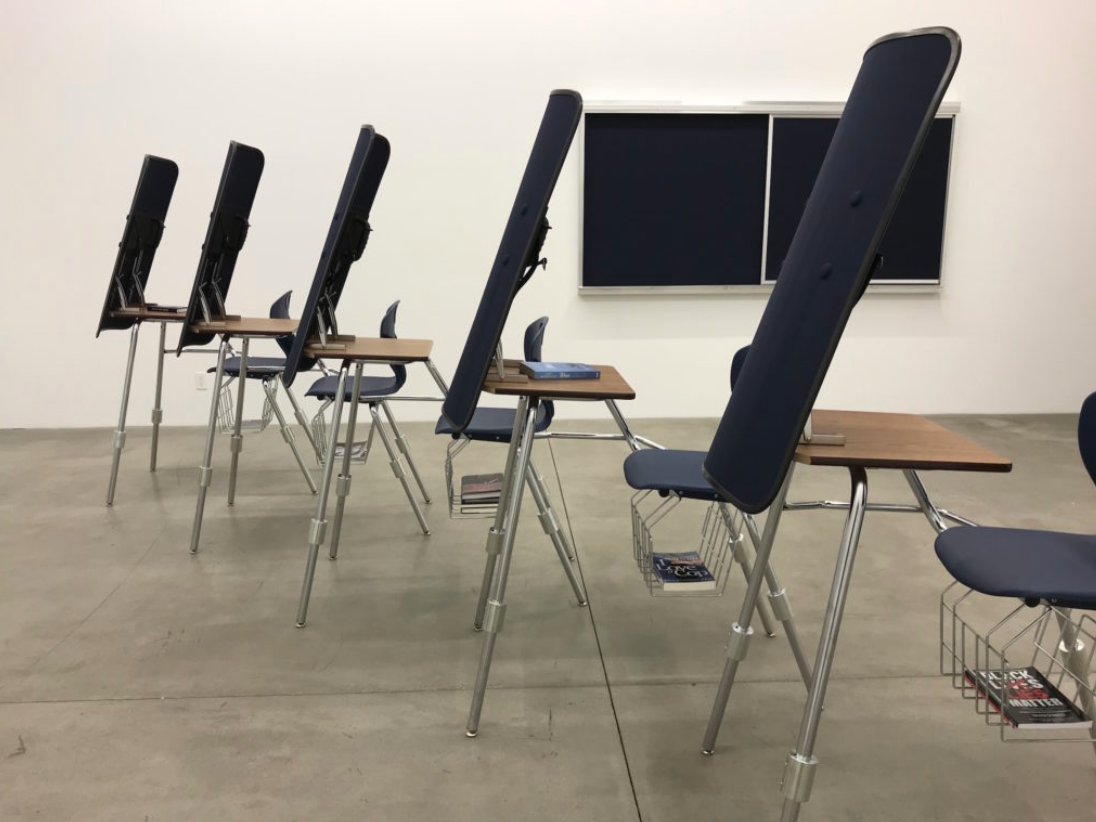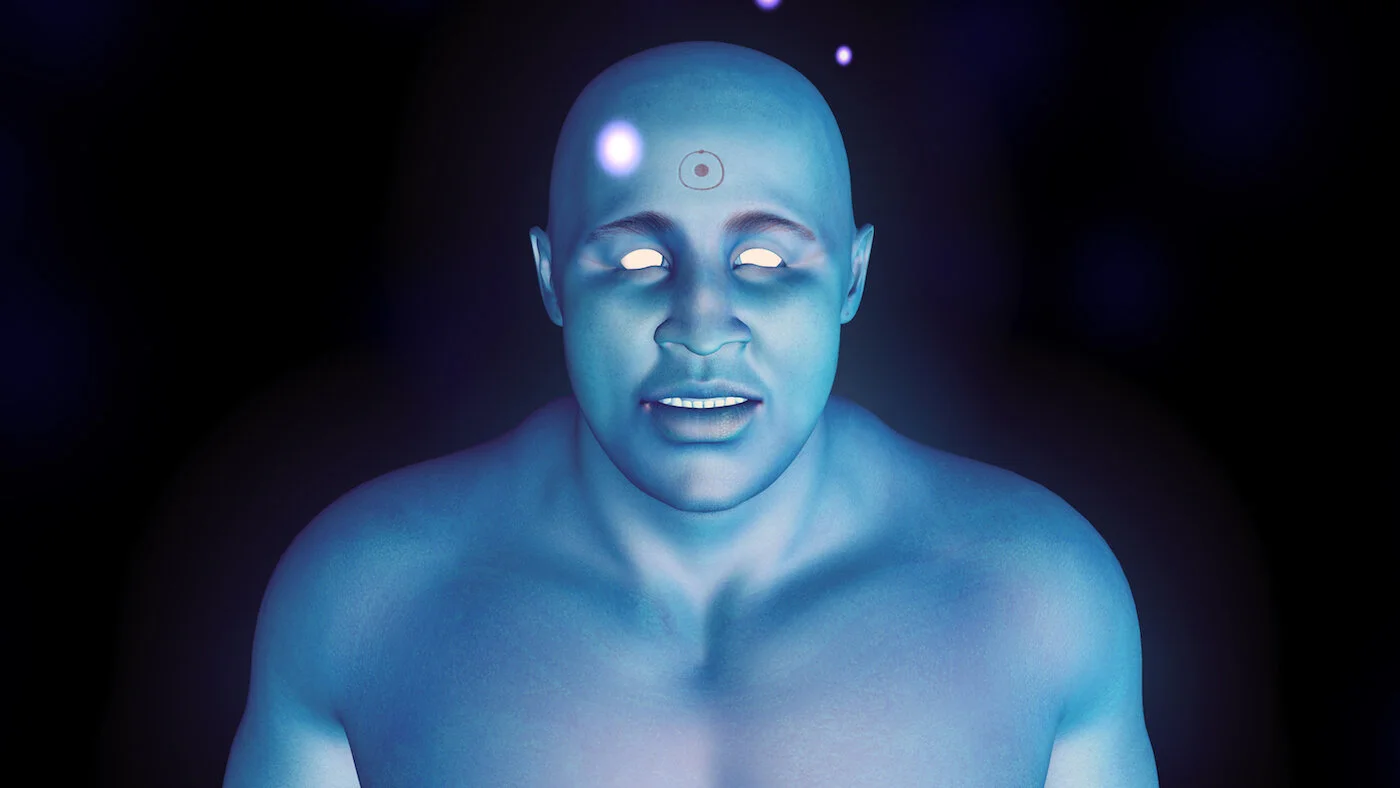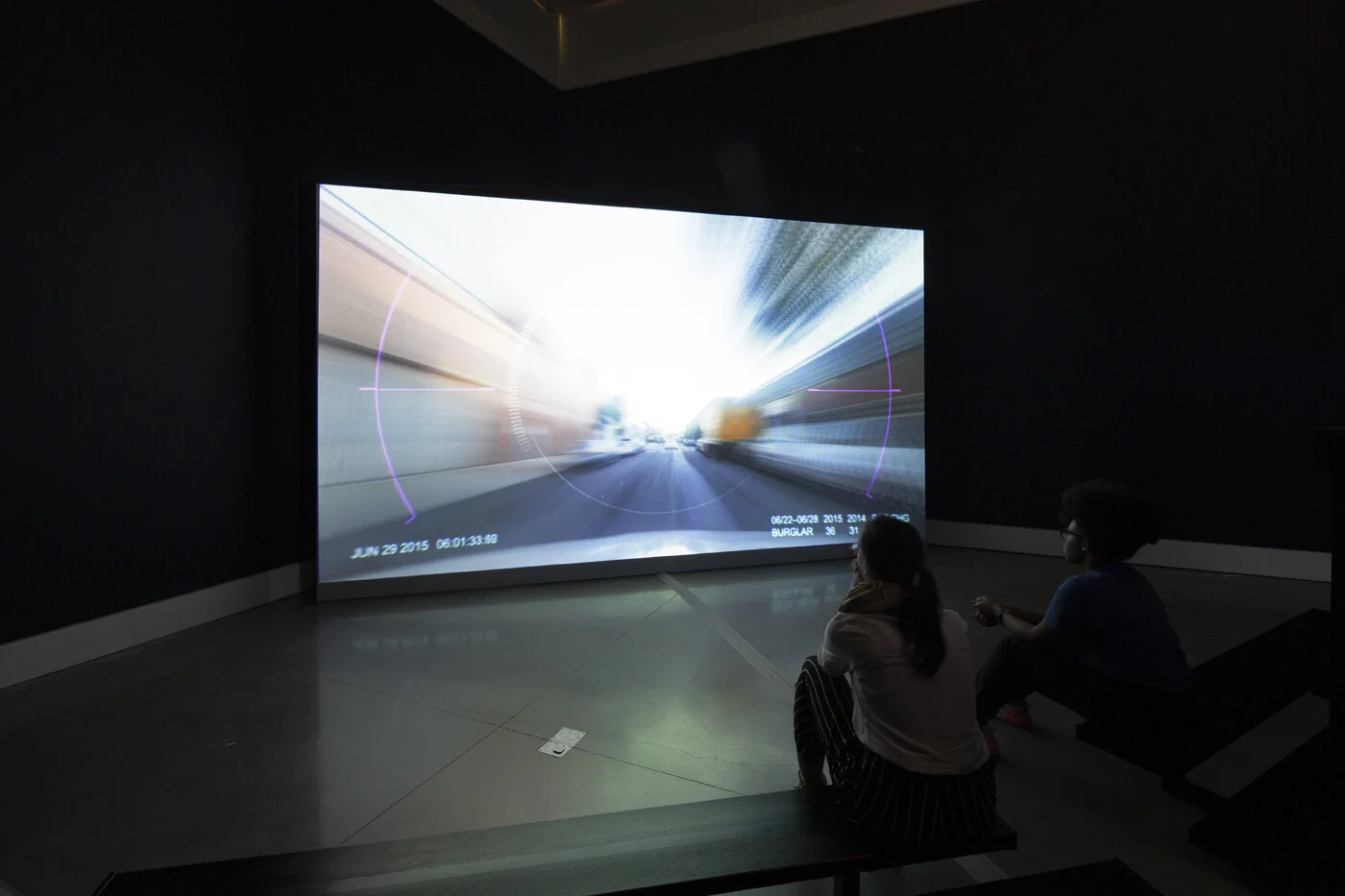I’m Blue (If I Was █████ I Would Die)
I’m Blue (If I Was █████ I Would Die) is the first solo exhibition of American-based artist American Artist, who chose to legally change their name and employ gender-neutral pronouns to challenge the notion of what an “American artist” should look like and highlight the concept of anonymity surrounding black identity.
Upon walking into the white-walled Koenig & Clinton Gallery of Brooklyn, visitors are presented with an exhibition space that has been rearranged to resemble an instructional seminar for law enforcement personnel. The space is unsettling and is made even more so by the bright fluorescent lights that shine from directly above. On the far wall hang a set of blackboards covered in a navy fabric that closely resembles the uniforms worn by law enforcement. Bisecting the room are six classroom desks, each reinforced with a ballistic shield covered in the same blue fabric.
American Artist, I’m Blue (If I Was █████ I Would Die), 2019. Installation view at Koenig & Clinton Gallery.
A set of algorithmically suggested textbooks on police psychology lie in the basket below each seat with titles such as Behind the Badge: 365 Daily Devotions for Law Enforcement (2018) and Black Lies Matter: Why Lies Matter to the Race Grievance Industry (2016). But it is the unique arrangement of the desks that draws in visitors and charges the brightly lit space with foreboding energy. They face the front of the room in a barricade formation known to be employed by riot police when confronting a threat, which looms at the front of the exhibit as the focal point of the room: a blue-skinned 3D animated avatar displayed on a flat-screen.
The figure is a hybrid of a real and a fictional persona who narrates sentiments that are an amalgamation of real and fabricated phrases. Its blue skin, glowing white eyes, and atomic insignia are derived from Dr. Manhattan, a character from the popular Watchman series whose unique features resulted from a nuclear accident that also endowed him with superhuman abilities. The government later sought out to exploit these traits, causing Dr. Manhattan to become disillusioned and escape to Mars to avoid being weaponized. The figure’s features are modeled after Christopher Dorner, a former LAPD officer who set on a vengeful killing spree after writing a 6,000-word manifesto detailing his disillusionment with the racial bias pervading the law enforcement system. The 20-minute monologue consists of phrases by American Artist blended in with excerpts taken directly from Dorner’s manifesto.
American Artist, still from Blue Life Seminar
The message is forward without being overly aggressive. It is a commentary on the countermovement of Blue Lives Matter, which rose up in response to the perceived malice that the Black Lives Matter movement was harboring towards law enforcement. According to American Artist, the idea for the elements in I’m Blue (If I Was █████ I Would Die) began to manifest itself after several legislative actions were taken to criminalize actions made against law enforcement officers. Deriving the title from the frequently misheard lyric of Eiffel 65’s pop song “Blue(da ba dee)” assigns the exhibit an almost grim yet satirical feel as if it too is entrusting its interpretation to the agency of visitors. Artist-focused journal HyperAllergic expressed that:
“Lyrics are reframed as a kind of rallying chant for the Blue Lives Matter movement: we’re Blue and invincible; any other color must die. ”
Visitors further get this sense of open-mindedness with the overall more peripheral take on the sensitive topic. It is less direct and forceful than some pieces, which allows visitors to speculate and extract different meanings. The intentionality of “blacking” out the word often misheard to be “green” is also charged with heavy implications. It first implies not only a sense of “blackness,” but that simply having darker skin increases the chance of dying due to racially charged acts of violence - in this case at the hands of racially driven police brutality. It implies that this same group is much more likely to be silenced and overlooked for something more favorable. Drawing a parallel between the two personas used in the animation, both found themselves in a statement of disillusionment with the state who had been setting them up against causes they wouldn’t support. Though here the similarities end, their reactions to their situations place them at a juxtaposition: one chooses to remove themselves from the equation, the other chooses to seek revenge.
American Artist’s practice frequently points to this discrepancy ingrained in American institutions. Most recently they have exhibited My Blue Window (2020), an immersive multimedia installation that explores the structural bias present in algorithms used by institutional systems. In a way, it advances the ongoing dialogue that I’m Blue (If I Was █████ I Would Die) began - choosing instead to focus on how institutions falsely claim technology is completely objective.
My Blue Window, Installation View (Queens Museum, Corona, NY)
At around the time of increased occurrences of police brutality, Maps Glover is another artist creating pieces to speak against it. He created an installation piece titled What We Leave Behind: In the Name of Art that used physical paper cranes and intentional color to speak for the silenced voices of those killed by police brutality. Installation pieces such as these shine a spotlight on the racial bias that pervades and dictates American systems. They encourage dialogue, elicit discussions, and aim to incite action or at the very least empathy. American Artist’s exhibition does just this, it has visitors speculate, discuss, and wonder at why this double standard is held between the Black Lives Matter movement and the Blue Lives Matter. It presents just enough information through the animation, sculptural works, color choices, and arrangement to encourage thought and question the system, but doesn’t sway them one way or the other.
Sources:
Artist, American. “I'M BLUE (IF I WAS █████ I WOULD DIE).” American Artist. https://americanartist.us/works/im-blue
Artsy. “I’m Blue (If I Was █████ I Would Die).” Artsy. https://www.artsy.net/show/koenig-and-clinton-im-blue-if-i-was-number-number-number-number-number-i-would-die
Masharani, Vijay. “American Artist: I'm Blue (If I Was █████ I Would Die).” The Brooklyn Rail. https://brooklynrail.org/2019/04/artseen/American-Artist-Im-Blue-If-I-Was-I-Would-Die
Tan, Ken. “A Classroom Where the Blue Lives Matter Movement Is the Central Curriculum.” Hyperallergic. https://hyperallergic.com/493868/a-classroom-where-the-blue-lives-matter-movement-is-the-central-curriculum/
True Love Industries “American Artist’s ‘I’m Blue (if I was I Would Die)’ @Koenig & Clinton in New York.” AUTRE. https://autre.love/journal/2019/3/4/american-artist-im-blue-if-i-wasnbspnbspinbspwould-die-koenig-amp-clinton-in-new-york
Schneider, Tim. “Alan Moore’s ‘Watchmen,’ a Killer Cop’s Ghost, and the Blue Lives Matter Movement Collide in a Politically Charged Gallery Show.” artnet. https://news.artnet.com/exhibitions/american-artist-blue-lives-matter-1477762
Vogel, Wendy. “American Artist.” ArtForum. https://www.artforum.com/picks/american-artist-79001








